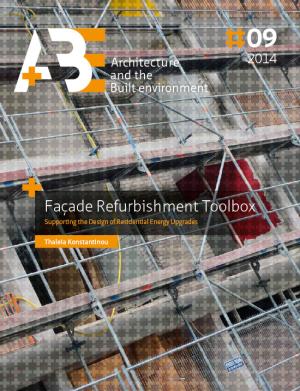Hosted by
Facade Refurbishment Toolbox: Supporting the Design of Residential Energy Upgrades
Synopsis
The starting point of the research is the need to refurbish existing residential building stock, in order to reduce its energy demand, which accounts for over one fourth of the energy consumption in the European Union. Refurbishment is a necessary step to reach the ambitious energy and decarbonisation targets for 2020 and 2050 that require an eventual reduction up to 90% in CO2 emissions. In this context, the rate and depth of refurbishment need to grow. The number of building to be renovated every year should increase, while the energy savings in renovated buildings should be over 60% reduction to current energy demand. To achieve that, not only is it necessary to find politics and incentives, but also to enable the building industry to design and construct effective refurbishment strategies. This research focuses on refurbishment of the building envelope, as it is very influential with regard to energy reduction.
The early design phases are particularly important, as decisions taken during this stage can determine the success or failure of the design. Even though the design decisions made earlier can have bigger impact with lower cost and effort, most existing tools focus on post-design evaluation. The integration of all aspects during the early design phases is complex, particularly as far as energy efficient design is concerned. At this stage, architects are in search for a design direction to make an informed decision. If the designer is provided with an indication of how efficient refurbishment options are, it is possible to apply them as part of an integrated strategy rather than trying to add measures at later stages, after the strategy has been developed.
Therefore, taking into account the need to refurbish residential buildings and the importance of integrated design of façade refurbishment strategies, the thesis aims at answering the following question.
How can the energy upgrade potential of residential façade refurbishment strategies be integrated in the early design phase, in order to support decision-making?
The objective of the research is to enable the design of refurbishment strategies that acknowledge the potential of energy savings. Having available an assessment of the energy performance results in informed decisions that improve the efficiency of the strategy and the final refurbished building.
The answer to the research question is given by the Façade Refurbishment Toolbox (FRT) approach. It consists of three different types of information that can support the decision-making of residential façade refurbishment strategies. Firstly, the building envelope components that need to be addressed in an integrated refurbishment strategy are identified and different retrofitting measures for each one are proposed, composing the façade refurbishment toolbox. Secondly, the measures are quantified in terms of energy upgrade potential, expressed by the simulated energy demand reduction after the application of the measure. Finally, a roadmap to the key decision aspects in the refurbishment strategy development indicates when the toolbox information can be used.
The methodology used to develop the FRT approach includes organising and calculating information about component retrofitting measures. The steps of the methodology were developed in the different chapters of the thesis. The first three chapters (Chapters 2-4) comprise the theoretical background that shapes the research question, discussion of the residential building stock, energy performance and refurbishment practice. Chapters 5 and 6 describe the process of the composition of the toolbox. Finally, Chapters 7 and 8 are concerned with its further applicability, regarding the approach validation and usability.
This thesis concludes with an approach to enable informed and energy-efficiency conscious decisions in the early stage of the design of refurbishment strategies. To improve the design process, the Façade Refurbishment Toolbox facilitates the development of strategies in different cases and for different specifications, without limiting or dictating designers’ choices.
Designing is deciding. Knowledge and information can lead to better understanding of a decision consequent and, therefore, result in better design solutions. Different buildings have different energy saving potential. They also have different specifications, performance requirements and design ambitions. All these parameters result in different refurbishment strategies. The aim of the proposed approach is not replacing the design process and generating a solution, but supporting it by providing information to lead into responsible and knowledgeable decisions. In this way, refurbishment strategies that take into account the building improvement, occupants’ comfort and efficient energy use can be designed, contributing to the greater society’s goals of CO2 emissions reduction and sustainable development.

